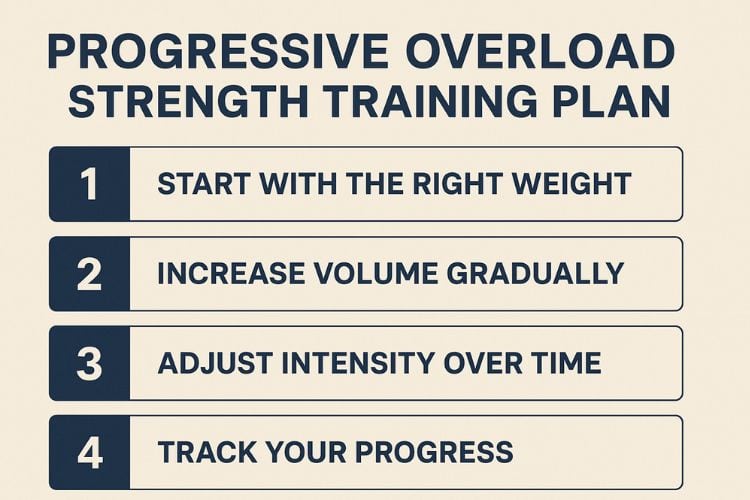Sign up for workout ideas, training advice, reviews of the latest gear and more.






Progressive overload is one of the most effective and science-backed methods to build strength, muscle, and endurance over time. Whether you’re just starting your fitness journey or have been lifting for years, applying progressive overload to your workouts ensures you keep improving and avoid plateaus. This guide will walk you through a complete progressive overload strength training plan, explaining the principles, techniques, and a sample program you can follow for lasting results.
Progressive overload is the gradual increase of stress placed on the body during exercise training. The idea is simple — to get stronger, you must continually challenge your muscles by increasing the intensity of your workouts. Over time, this controlled stress forces your body to adapt by building more muscle, enhancing strength, and improving performance.
Muscles grow and strengthen when they’re exposed to a level of resistance that exceeds their current capacity. By progressively increasing load or intensity, your body responds by making physiological changes — stronger muscle fibers, increased bone density, improved neural efficiency, and greater metabolic capacity.
Without progressive overload, your muscles have no reason to adapt, leading to stagnation or “plateaus.”
The most straightforward way to apply progressive overload is by gradually increasing the amount of weight you lift. For instance, if you’re doing 10-pound dumbbell curls comfortably, moving up to 12 or 15 pounds challenges your muscles further.
If you’re not ready to add more weight, increase your repetitions with your current load. For example, move from 8 to 10 or 12 reps before increasing the weight.
Adding an extra set to your workout adds training volume, stimulating greater muscle adaptation.
Progressive overload isn’t always about lifting heavier. Performing exercises with better form and deeper range of motion enhances muscle activation and functional strength.
Shortening rest periods between sets increases metabolic stress and cardiovascular demand, helping improve endurance and calorie burn.
Adding an extra workout day for a specific muscle group or training area can contribute to faster progress — provided recovery is managed properly.
Progressive overload doesn’t just build muscle — it transforms your entire fitness level. Here are the top benefits:
By consistently challenging your muscles, you’ll see measurable increases in how much weight you can lift over time.
Gradually overloading your muscles promotes hypertrophy — an increase in muscle size — which enhances tone and definition.
Overload training not only strengthens muscles but also improves their ability to perform for longer durations.
As your lean muscle mass increases, your resting metabolic rate rises — meaning you’ll burn more calories even at rest.
When done properly, progressive overload strengthens tendons, ligaments, and stabilizing muscles, creating a more resilient body.

Before you increase anything, know your starting point. Track your weights, sets, and reps for each exercise.
Increase load or intensity by 5–10% at a time. Jumping too fast can lead to fatigue or injury.
Keep a workout log or use a fitness app to record your performance. Seeing your progress keeps you motivated and helps ensure consistent progression.
Muscles need time to rebuild. Get enough sleep, hydrate, and include rest days in your plan.
If you’re constantly sore or feeling fatigued, scale back. Overtraining can stall progress and increase injury risk.
For most lifters, adjusting your load every 1–2 weeks is ideal. Beginners may progress faster at first, while advanced lifters require smaller and more strategic increases.
A good rule of thumb:
Increase weight gradually each week (e.g., +2.5 to 5 lbs). This is ideal for beginners who see consistent improvement early on.
Increase reps first within a given range before adding more weight. For example, if your rep range is 8–12, move from 8 reps to 12 before increasing the load.
Alternate between heavier and lighter weeks to avoid burnout and keep muscles guessing.
Example:
Start with lighter weights and higher reps, then increase the weight while decreasing the reps each set. This helps target both endurance and strength fibers.
This plan is designed to help you build strength and muscle safely and effectively using the principles of progressive overload. It can be done at home or in the gym with dumbbells, barbells, or resistance bands.
| Day | Focus |
|---|---|
| Monday | Lower Body Strength |
| Tuesday | Upper Body Push |
| Wednesday | Rest or Active Recovery |
| Thursday | Upper Body Pull |
| Friday | Full Body |
| Saturday | Core & Stability |
| Sunday | Rest |
Focus on learning proper form and establishing your baseline weights.
Add 5–10% more weight or increase repetitions by 2–3 per set.
Start to challenge yourself with slightly heavier weights while maintaining proper form. Focus on controlled movements and full range of motion.
Increase load again or reduce rest times between sets (e.g., from 60 seconds to 45 seconds). You can also add a fourth set to your main lifts like squats, rows, and presses.
Track your lifts in a journal. If you can perform more than your target reps easily, it’s time to increase the weight again.
Push yourself toward your new strength potential. You should now feel noticeably stronger compared to Week 1.
Finish with 5 minutes of stretching, focusing on the legs, shoulders, and lower back.
Muscle growth requires energy and nutrients. Focus on protein-rich foods (chicken, eggs, tofu, fish) along with complex carbs (brown rice, oats) and healthy fats (avocado, olive oil).
Aim for 0.8–1 gram of protein per pound of body weight daily. Protein helps repair and build muscle tissue after each workout.
Dehydration can reduce performance. Drink water throughout the day and more during intense workouts.
Have a balanced pre-workout meal with carbs and protein 1–2 hours before training. Afterward, refuel with a protein shake or a meal containing lean protein and carbs.
A progressive overload strength training plan is your key to continuous improvement. By gradually increasing resistance, tracking your progress, and maintaining proper recovery, you’ll not only build muscle but also develop lasting strength and confidence.
Whether you’re training at home or in the gym, remember: progress happens over time. Stay patient, consistent, and committed — your future stronger self will thank you.
Stay up to date on the latest women’s health, fitness and lifestyle trends and tips.